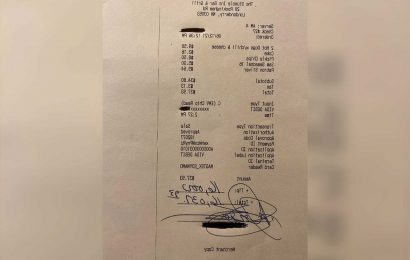RUSSIA could invade Ukraine by the end of January with a massive assault across ten fronts, intelligence chiefs have warned.
Ukrainian commander Kyrylo Budanov, the head of Kiev's defence intelligence agency, laid out the scale of Vladimir Putin's attack involving some 100,000 soldiers.
Brigadier General Budanov explained the invasion would involve airstrikes and artillery bombardments following by an attack from the air involving up to 3,500 paratroopers and special forces, reports The Military Times.
It would then be followed by a mass assault across the border, amphibious landings in Odessa and Mariupol, and a smaller attack from neighbouring Belarus.
Ukrainian intelligence also produced a map-based assessment about how Russia may seek to invade detailing attacks across at least ten fronts.
Russia however has always denied any aggressive intentions towards Ukraine – branding the latest reports as "hysteria".
Kiev officials have claimed Putin has deployed 40 "battalion tactical groups" (BTGS) to the border with the former Soviet state.
BTGs are formations of troops, armour, air forces and artillery which are designated specific missions by the Russian Army.
Such missions in this case would be a full scale invasion of Ukraine.
The map also lists Russia as having 94,000 troops, 1,200 tanks, 1,600 pieces of the artillery, 330 aircraft, 75 warships and six submarines in the region.
Budanov warned the conflict would be far more devastating than anything seen in the last seven years of conflict between the two powers in Eastern Europe.
He believes that Russia may be preparing for an attack by the end of January or at the beginning of February.
And he dismissed suggestions Putin would be put off by the wintery conditions, saying "it is no problem for us and the Russians".
The commander explained Kiev is monitoring troops and weapons massing near the border – including short range missile systems.
They want to make the situation inside the country more and more dangerous
Budanov added Russia will first attempt to further destabilise Ukraine by stoking unrest, protests and attempting to undermine the government of president Volodymyr Zelensky.
And this has included ongoing anti-vaxx protests that Ukraine believes have been organised by Putin's regime.
He also blamed the ongoing border crisis between Belarus and Ukraine on the Russians.
Budanov said: "They want to make the situation inside the country more and more dangerous and hard and make a situation where we have to change the government.
"If they can’t do that, than military troops will do their job."
US intelligence reportedly support the assessment that Russia is preparing for an invasion of Ukraine.
Sources claimed that the Pentagon has briefed NATO allies with their information amid efforts to deter Russia.
What is happening between Russia and Ukraine?
RUSSIA and the Ukraine have remained technically at war since 2014.
Ukraine was aligned with Russia as part of the Soviet Union until its collapse in 1991, following which it became an independent state.
Both nations remained closely tied – but Ukraine gradually began to distance itself, seeking deeper ties with the West.
The open conflict was triggered by the Ukrainian Revolution in 2014 – when an uprising overthrew the pro-Russian government of Viktor Yanukovych.
Vladimir Putin's forces reacted by annexing the region of Crimea from Ukraine – a move which was widely condemned by the West.
The conflict then spiralled when pro-Russian groups in Eastern Ukraine then took up arms against the state.
Russia gave their backing the separatist forces which formed breakaway republics in Donetsk and Luhansk.
Putin's forces then launched a military incursion into these regions as they gave their support to the rebels.
Russia continues to hold Crimea – and claims the region joined them willingly after they a referendum.
Seven years have now passed and the War in Donbass remains at a stalemate.
It is estimated some 14,000 have been killed in the conflict, including more than 3,0o0 civilians.
Ukraine and the rebels signed a new ceasefire in July 2020 – but clashes have been steadily increasing again throughout 2021.
US defence secretary Lloyd Austin met with his Ukrainian counterpart and last week said Washington continues to monitor "troubling behaviour" from Russia.
He said: "We are not sure exactly what Mr. Putin is up to.
"But these movements certainly have our attention. And I would urge Russia to be more transparent about what they are up to take steps to live up to the Minsk agreements.
“Our support for Ukraine sovereignty territorial integrity remains unwavering."
Officials also confirmed the US has "serious concerns" about Russia's military activities which they consider pointed at Ukraine.
"We have had extensive interactions with our European allies and partners in recent weeks, including with Ukraine," an official told The Hill.
"As we have said during the public readouts of those meetings, we’ve discussed our concerns about Russian military activities and harsh rhetoric towards Ukraine.
"We have also held discussions with Russian officials about Ukraine and US-Russian relations generally."
BLITZKRIEG
It comes after earlier this month Britain's top general Nick Carter warned the chance of an "accidental" war with Russia is now the highest in decades.
And meanwhile Whitehall officials were described as being worried and twitchy about the troubling intel emerging from the East.
Previous analysis has suggested Putin's attack on Ukraine would follow a similar template to the "blitzkrieg" assaults across Europe used by the Nazis.
Russia would seek to hit a knockout blow before Ukraine and the West could react and redraw the "frontline" – similar to what happened in Crimea in 2014.
Putin would attempt to brand the seizure of the land as a "liberation"- much as they did seven years ago.
On Sunday, Vladimir Putin's spokesman Dmitry Peskov said: "The ones who are accusing us of some kind of unusual military activity on our own territory are themselves sending their armed forces from across the ocean.
"I mean the United States of America. It’s not very logical and not very decent."
Source: Read Full Article








